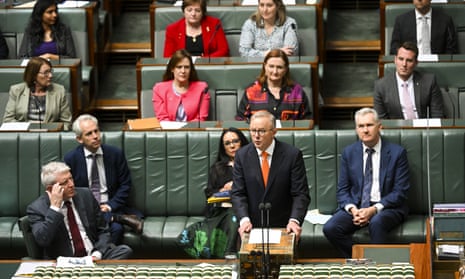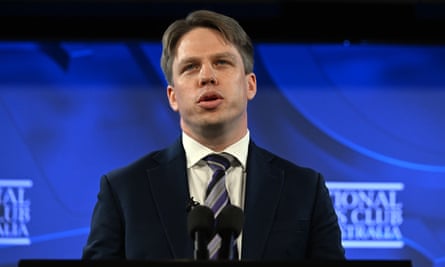Extract from The Guardian

If you’ve missed it, let’s catch up quickly. Labor’s efforts to implement multi-employer bargaining to boost wages growth hasn’t won universal approval. The case study confirms progressivism in this parliament runs along a spectrum from centre-right to centre-left to hard left.
There’s a very old proverb in Australia: money runs Sydney and the unions run Melbourne. This is a gross generalisation, and the whole notion feels pretty antiquated in the modern economy, but I remembered it this week when the Melbourne teal independents – Monique Ryan and Zoe Daniel – voted with the government on the second reading of the industrial legislation, while the Sydney contingent opposed the policy.
There’s nothing sensational or surprising about a split inside the teal bloc, and between some of the teals and Labor. Disagreement was inevitable, because the teals are progressives, but they occupy Liberal seats. The teal base is predominantly (but not exclusively) small “l” liberal, post-material voters who feel estranged from the contemporary Liberal party. Some of the young progressives who voted teal in 2022 (as well as Labor voters, voting tactically in these contests) are probably entirely comfortable with institutionalised collectivism in the form of pattern bargaining and union representation – but I suspect the older, Liberal-estranged cohort, not so much.
This week’s fracture in the House is interesting but not material given the fate of the package will ultimately be decided in the Senate, where the ACT independent David Pocock has the whip hand.
In any case, the industrial package is not my primary focus this weekend. I want to draw your attention to another fascinating difference of views playing out largely under the radar.
Let me start with full disclosure. I am one of those weirdos who enjoys the post-election ritual that is the joint standing committee on electoral matters (Jscem) inquiring into the conduct of federal elections.

Labor has been trying to secure some basic integrity reforms for years, to no avail. The new government signalled after the May election it wanted to have another go at electoral reform, including legislating spending caps, and creating a truth in political advertising regime. The government also wants donations disclosed in real time, not many many months down the track, and to implement a $1,000 donation disclosure threshold (instead of the $15,200 that exists currently).
Let’s start with the good news. Labor will likely be able to deliver donations transparency in this parliament. The Liberal party may even accept Labor’s electoral mandate on that point.
But if we return now to our progressive schism, key differences will play out around the proposed caps on electoral expenditure.
Labor’s national secretary, Paul Erickson, defines the current problem in his submission to Jscem. He says the current lack of restrictions “has allowed extremely high-net-worth individuals, groups, and networks to distort the political conversation with levels of advertising that were previously inconceivable in Australian elections”.
Erickson is talking predominantly about Clive Palmer, who has spent north of $100m over the last few election cycles. But he is also talking about Climate 200 – the political action entity that has supercharged the teal independents movement. According to the latest disclosures released this week, the teal campaigns in 2022 were powered by $10.2m of political donations. Climate 200 raised $13m and donated to 23 campaigns. That’s a big spend.
In a structural sense, Labor benefits from the existence of the teal buffer state. As long as it exists, it will be difficult for the Coalition to form majority government, or even minority government, at least while ever Peter Dutton persists in being an Abbott-era tribute band when it comes to climate policy.
The Liberal party’s submission to Jscem sounds lukewarm at best about spending caps, but I suspect they are going to want to be at the table as this particular question gets resolved.
The funny thing about all the positioning is everybody has a point.
Erickson is right. I strongly suspect Australians don’t want to be spectators in an electoral arms race where high wealth individuals exercise oversized influence in our democracy. It is sensible for the Liberal party to pose a bunch of detailed questions – would this proposed cap apply just to campaigns, or all political expenditure; would the cap apply to political parties or to third parties as well; would there be different rules for different types of elections? It is also entirely reasonable for Climate 200 to point to the incumbency advantage the major parties enjoy through access to things like taxpayer-funded communications budgets, or early access to the electoral roll. There is an incumbency advantage, no question (although I can’t help but chuckle about this highly professional group asserting insurgency status when, in political terms, they are the new incumbents).
The questions the Liberal party campaign director, Andrew Hirst, poses in his submission will find answers as we move from spit-balling to a fleshed-out policy model. Perhaps some of Climate 200’s entirely legitimate concerns about the incumbency advantage could be addressed by things like changes to government advertising rules and a different cap for independents and major parties. This is assuming, of course, that this group of actors is genuinely interested in compromise.
No comments:
Post a Comment